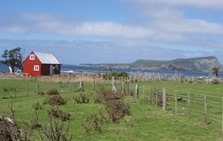The Chatham Islands are regarded as being the last islands in the Pacific to be permanently settled by people.
Moriori, Māori and European settlement in the Chatham Islands has left a variety of historic resources representing the cultural occupation of the lands by these people. Examples of this occupation are common on land managed by the Department, and include the remaining two major concentrations of Moriori tree carvings in Hāpūpū/J.M. Barker Historic Reserve and Taia Bush Historic Reserve.

Glory Cottage, Pitt Island
Other occupation sites include middens, quarries, burial and other wāhi tapu sites which are common all around the island group. Over 700 archaeological sites are recorded on the Chatham Islands.
European historic sites relate to whaling, sealing, missionaries, agriculture and fishing.
Physical remnants include the:
- Pitt Island Glory Cottage (c.1860) and
- the woolshed and sheep dip site on Rangatira.
One of only three national historic reserves in New Zealand, Hāpūpū protects Moriori rakau momori (tree carvings).